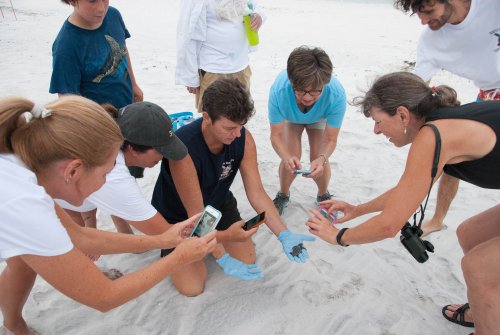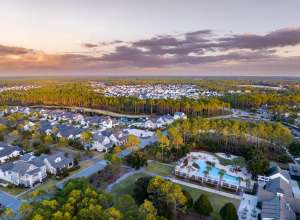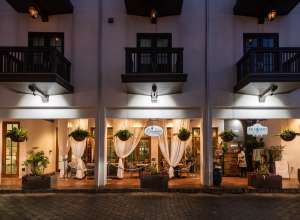Story
South Walton Turtle Watch Volunteers Patrol the Beach
August 21, 2015 by Manny Chavez

A giant red sun peeks over the oat-covered dunes, casting long shadows and illuminating a distinctive track in the sand, unbroken from dune toe to surf. The track was made in the midnight hour by a massive sea turtle on a mission.
Expectant mamas like her have been visiting SoWal beaches since prehistoric times, returning each year to the same spot where they hatched. Repeating the cycle by building a nest and burying dozens of eggs in the warm, incubating sands.
Volunteer Valerie Lofton still feels the thrill of finding tracks on her early morning walks as a South Walton Turtle Watch (SWTW) member. She's specially trained to spot the tracks and mark nests. From experience, she can tell what species of sea turtle has made the tracks. To Valerie, the tracks mean life. The tracks are a connection to the past, and the future. As South Walton County becomes more popular with tourists each summer, our turtles need more protection.

Valerie and fellow volunteer Jennifer Sullivan have carefully marked the nest for protection with stakes and warning tape, now they begin to carefully clear sand to pinpoint the exact location of the eggs. This particular nest belongs to a massive loggerhead turtle.
The nest was a little troublesome to pinpoint, as the mother turtle started to lay her eggs in a couple of different spots before finally settling down for nesting. Valerie and Jennifer locate the eggs, and cover the holes back up. A single stake is marked as to the date of the nesting and the nest number for this year. This particular nest was Walton County nest #72, a pretty high number for established turtle nests for this time of year.

Sea turtles that nest in Walton County include the loggerhead, green, leatherback, and the Kemp’s ridley. Nesting season runs from May through October. Each nest will usually contain from 70-170 eggs and every documented turtle nest is accounted for by the volunteers. The eggs will hatch in about two months.
Only one kemp’s ridley nest has been found and documented by the group this year in SoWal and this particular species is critically endangered. The other three are all on the endangered list.
Started in 1995 by Sharon Maxwell, SWTW has grown to more than 80 volunteers, who are required to attend a training class prior to becoming SWTW walkers (walkers take to the beaches early morning prior to sunrise and also at night).

Maxwell was able to obtain a permit for the group and still holds it for the purpose of being able to legally track, dig, collect, and process all the data relating to sea turtle conservation. The permit allows for members to handle the eggs and hatchlings when necessary to make sure they can crawl to the gulf for a chance to live long enough to return to SoWal to lay their own eggs.
Incredibly, the little female hatchlings will have to live for about 25 years before they are mature enough to mate and lay eggs. They will instinctively return to the place they hatched from their nest right here in SoWal. They are then able to nest three or four times during a season. Every element of the process, from finding a crawl (even if it is a false crawl where the turtle comes ashore but doesn’t lay her eggs) to the hatchlings entering the water, is documented by the SWTW volunteers and reported to Florida Fish and Wildlife Commission (FWC).

Sharon leads the SWTW group with the help of three coordinators (Valerie Lofton, Bobby Stewart, and Erica Magera) who oversee their dedicated volunteer walkers patrolling the 26-mile SoWal beach area.
For the most part, sea turtles will lay their eggs at night. The females will “wait it out” during the day, often resting in the Gulf near the second sandbar until darkness comes and beach traffic subsides. For nesting turtles, this is where humans tend to interfere with their natural process.
The hazards on the beach made by humans include signs and poles, holes and sand castles, beach chairs, umbrellas, tents, toys, boats and other items. Bright lights from houses, businesses, vehicles, and from people walking the beach with flashlights….all are major deterrents for the exhausted mother sea turtles who have instinctively journeyed thousands of miles just to lay their eggs.
In an effort to educate the public regarding the sea turtle nesting and hatching cycle, a new group called Friends of South Walton Sea Turtles formed this year and they are busy printing materials for SoWal vacation rentals and area businesses. The group, headed by Beth Copeland, currently has 13 “very strong” volunteers who have put their efforts to work using social media to get the word out.

Their group is also providing fun educational readings for kids kids understand the plight of the sea turtle and the role that we humans play in their survival.
On rare occasions, a sea turtle will lay her eggs during the daylight hours and newbie turtle walker Elaine Parrett and her husband Dan were lucky enough to witness a mama loggerhead lay her eggs and retreat back into the gulf during her usual early morning walk.
What a wonderful treat for a walker to experience! This particular nest had been dug and left too close to the water by the loggerhead, so permitted turtle watch volunteers had to gather up the eggs and move them closer to the dunes.
Following the incubation period and the actual hatching of the eggs, all nests will be opened once again for a 72 hour post- hatching evaluation to make sure all the eggs have hatched. On a recent evaluation, veteran turtle walkers Bobby and Anne Stewart (they are permitted to handle the little hatchlings) uncovered 35 more hatchlings still in the sand and the little ones were carefully placed in a sandy ice cooler to be let loose at dark.
Watching these tiny-flippered young ones head out to sea makes all the volunteer efforts seem worth it and one has to hope that in another 25 years or so, they will return to the very same beach they were born to lay their own eggs. If people will just give them a chance and they are able to avoid their own sea predators, all will be good…thanks in a large part to the efforts of the very dedicated volunteers of the South Walton Turtle Watch.
For Turtle Watch information, call 850-276-2277. Web site: www.southwaltonturtlewatch.org Donations and volunteer information can be found on their site.
Follow South Walton Turtle Watch on Facebook for exciting photos and news by SWTW volunteers reporting nests and hatchlings. Sea turtle season 2015 is a very exciting year!
Follow Friends of South Walton Turtles on Facebook for education, facts, events, and ways to get involved. Read the Friends blog and sign up for the newsletter, "Dig It" for excellent SoWal sea turtle updates and info.
















